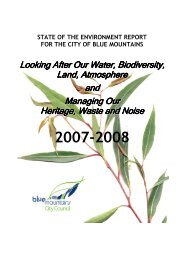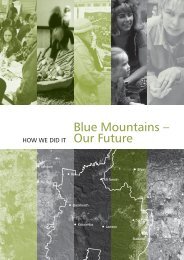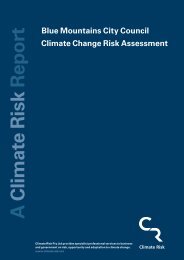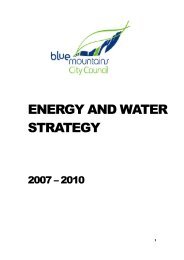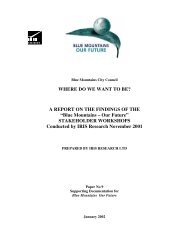State of the Environment Report for the City of Blue Mountains
State of the Environment Report for the City of Blue Mountains
State of the Environment Report for the City of Blue Mountains
You also want an ePaper? Increase the reach of your titles
YUMPU automatically turns print PDFs into web optimized ePapers that Google loves.
Our Atmosphere Resources<br />
What are atmosphere<br />
resources<br />
The atmosphere is <strong>the</strong> layer<br />
<strong>of</strong> gases that surrounds <strong>the</strong><br />
earth. The air we brea<strong>the</strong><br />
contains a mixture <strong>of</strong> gases<br />
including nitrogen (78 per<br />
cent), oxygen (21 per cent),<br />
carbon dioxide (0.04 per cent);<br />
trace amounts <strong>of</strong> o<strong>the</strong>r gases<br />
(argon, helium, xenon, neon<br />
and krypton); and water vapour<br />
(Commonwealth, 1996). In<br />
addition, air contains a variety<br />
<strong>of</strong> pollutants from both natural<br />
and human sources.<br />
Why is <strong>the</strong><br />
atmosphere<br />
important<br />
The atmosphere is an essential<br />
natural asset that supports <strong>the</strong><br />
health <strong>of</strong> <strong>the</strong> planet and our<br />
quality <strong>of</strong> life. Our atmosphere<br />
regulates <strong>the</strong> type and amount<br />
<strong>of</strong> radiation that hits <strong>the</strong> earth’s<br />
surface from <strong>the</strong> sun (<strong>the</strong> ozone<br />
layer), regulates temperature<br />
(through <strong>the</strong> greenhouse<br />
effect) and provides <strong>the</strong><br />
specific gases (air) that plants<br />
need to grow and animals<br />
including people need<br />
to brea<strong>the</strong>.<br />
Air quality can have a large<br />
impact on human and<br />
environmental health. Poor air<br />
quality can cost <strong>the</strong> community<br />
financially through loss <strong>of</strong><br />
productivity and increased<br />
health care costs, as well<br />
as a lowering <strong>of</strong> human well<br />
being cost. On days <strong>of</strong> high<br />
air pollution in NSW, daily<br />
mortality increases by<br />
2–3 per cent and hospital<br />
admissions increase<br />
6–7 per cent <strong>for</strong> heart disease,<br />
5–6 per cent <strong>for</strong> asthma, and<br />
2–3 per cent <strong>for</strong> respiratory<br />
diseases in <strong>the</strong> elderly<br />
(EPA, 1997).<br />
What are <strong>the</strong><br />
pressures on <strong>the</strong><br />
atmosphere<br />
Solid fuel heaters<br />
In <strong>the</strong> absence <strong>of</strong> bushfires,<br />
hazard reduction burning,<br />
domestic wood heating and<br />
diesel vehicles become <strong>the</strong><br />
major sources <strong>of</strong> primary<br />
particles in urban areas (EPA<br />
2003). The total number <strong>of</strong><br />
wood fuelled heaters in <strong>the</strong><br />
LGA and <strong>the</strong> number <strong>of</strong> air<br />
pollution complaints relating<br />
to wood heaters is currently<br />
a data gap.<br />
Backyard burning<br />
Open burning is a significant<br />
source <strong>of</strong> particle pollution (EPA<br />
2003). Until 1 September 2006,<br />
Councils were able to regulate<br />
<strong>the</strong> level <strong>of</strong> open burning in<br />
<strong>the</strong>ir municipality under <strong>the</strong><br />
Protection <strong>of</strong> <strong>the</strong> <strong>Environment</strong><br />
Operations (Control <strong>of</strong><br />
Burning) Regulation 2000.<br />
This regulation has now<br />
been repealed, however <strong>the</strong><br />
provisions <strong>of</strong> that regulation<br />
have now been incorporated<br />
into <strong>the</strong> Protection <strong>of</strong> <strong>the</strong><br />
<strong>Environment</strong> Operations (Clean<br />
Air) Regulation 2002. The<br />
Regulation prohibits burning <strong>of</strong><br />
certain articles and vegetation<br />
in urban areas and restricts it<br />
to appropriate levels in rural<br />
areas. The burning <strong>of</strong> dead<br />
and dry vegetation in <strong>the</strong> <strong>Blue</strong><br />
<strong>Mountains</strong> may be permitted<br />
in some circumstances after an<br />
application is made to Council.<br />
During <strong>the</strong> reporting period,<br />
Council received 564<br />
applications to light and<br />
maintain an open fire. Of<br />
<strong>the</strong>se applications, only 39<br />
approvals to burn dead and<br />
dry vegetation were issued,<br />
which represents approximately<br />
7 per cent <strong>of</strong> all applications.<br />
Prescribed burn, Linden<br />
Prescribed use <strong>of</strong> fire <strong>for</strong><br />
bushfire management<br />
Bushfire management activities<br />
involving <strong>the</strong> prescribed use<br />
<strong>of</strong> fire (<strong>for</strong> hazard reduction)<br />
are highly regulated, both<br />
operationally and with regards<br />
to potential environmental<br />
impacts. The <strong>Blue</strong> <strong>Mountains</strong><br />
Bush Fire Risk Management<br />
Plan contains references to<br />
smoke management, and <strong>the</strong><br />
need <strong>for</strong> operational plans to<br />
consider <strong>the</strong> effects <strong>of</strong> smoke<br />
on nearby residences, and<br />
sensitive locations such as<br />
hospitals, aged care facilities,<br />
schools and tourist centres.<br />
This plan states that all burn<br />
plans must include measures<br />
to reduce <strong>the</strong> impact <strong>of</strong> smoke<br />
as far as practicable.<br />
While a number <strong>of</strong> prescribed<br />
burns were conducted within<br />
<strong>the</strong> <strong>City</strong> during <strong>the</strong> reporting<br />
period, given <strong>the</strong> lack <strong>of</strong><br />
scientific data it is impossible<br />
to quantify <strong>the</strong> contribution<br />
prescribed burning has on<br />
reduced local and regional air<br />
quality. As <strong>the</strong> conditions that<br />
allow safe prescribed burning<br />
to be carried out also tend to<br />
inhibit smoke dispersal, it is<br />
reasonable to assume that<br />
prescribed fires do have a short<br />
term effect on local air quality.<br />
To a certain extent <strong>the</strong> impacts<br />
<strong>of</strong> smoke from prescribed fires<br />
can be managed, however,<br />
as with all fire <strong>the</strong> generation<br />
<strong>of</strong> smoke is an unavoidable<br />
product <strong>of</strong> such activities.<br />
Wildfire<br />
The impact <strong>of</strong> smoke resulting<br />
from wildfire is impossible<br />
to manage and may have<br />
significant implications <strong>for</strong><br />
local and regional air quality.<br />
Given <strong>the</strong> wea<strong>the</strong>r conditions<br />
that are conducive to very high<br />
and extreme fire danger in <strong>the</strong><br />
<strong>Blue</strong> <strong>Mountains</strong>, <strong>the</strong> occurrence<br />
<strong>of</strong> wildfire under <strong>the</strong>se<br />
conditions will typically result<br />
in large quantities <strong>of</strong> smoke<br />
being blown <strong>for</strong> long distances<br />
downwind <strong>of</strong> <strong>the</strong> fire. This has<br />
<strong>the</strong> potential to severely impact<br />
on air quality within <strong>the</strong> city,<br />
affecting residents, tourists<br />
and businesses alike. The<br />
composition <strong>of</strong> smoke from<br />
an intense wildfire may be<br />
substantially different from<br />
that <strong>of</strong> a low intensity<br />
prescribed burn, and exposure<br />
may have implications <strong>for</strong><br />
<strong>the</strong> health <strong>of</strong> persons with<br />
respiratory illness.<br />
Although numerous fires were<br />
attended and extinguished by<br />
both <strong>the</strong> NSW Fire Brigades<br />
and <strong>the</strong> NSW Rural Fire Service<br />
during <strong>the</strong> reporting period,<br />
<strong>the</strong> reported incidents were<br />
minor in significance and are<br />
unlikely to have contributed<br />
significantly to reduced local<br />
or regional air quality.<br />
24<br />
2005–2006 Supplementary <strong>State</strong> <strong>of</strong> <strong>the</strong> <strong>Environment</strong> <strong>Report</strong> <strong>for</strong> <strong>the</strong> <strong>City</strong> <strong>of</strong> <strong>Blue</strong> <strong>Mountains</strong>



